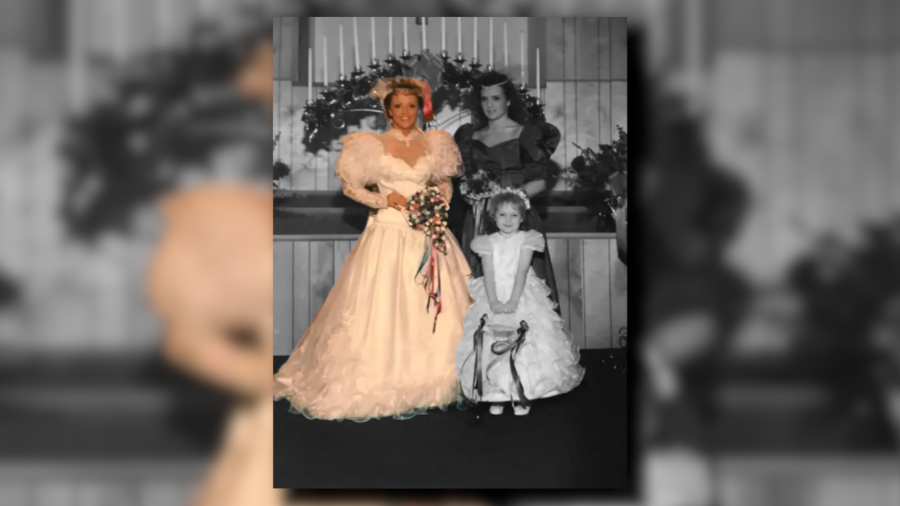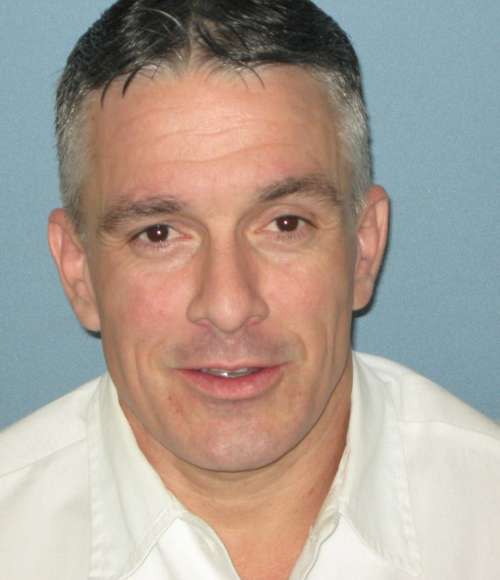32-year-old cold case gets a new look in a southeast Kansas homicide
- Oops!Something went wrong.Please try again later.
BAXTER SPRINGS, Kan. – For over three decades an eight-inch blood-stained knife blade remained securely packed away in a cardboard evidence box. Officials removed it from the back of a young Kansas woman, murdered just nine days after her wedding.

The broken knife recovered by deputies from Jennifer Bryan Judd’s back on May 11, 1992, was just one of the nine stab wounds to her body.
Jennifer’s homicide rocked the four-state area chiefly because of the brutality of her slaying and because the young newlywed had no known enemies nor did she participate in risky behaviors.
Robbery was ruled out after law enforcement officers recovered Jennifer’s purse at the scene which contained money. According to published reports and her autopsy, she was also still wearing her wedding rings.
Cherokee County Sheriff David Groves declined to discuss the specifics of the evidentiary items taken from the bloody crime scene at 219 Park Avenue in Baxter Springs, Kansas. Still, he said, “different items have been tested over the years.”
According to a May 12, 1992, search warrant provided by private investigator Stephen M. Garrett, 18 items were taken as evidence from the house. Those ranged from a bedspread, purple night shorts, blue shorts, a Minute Maid pop can, a knife rack holding 11 knives and a pair of scissors, a drawer with a variety of kitchen knives, sheetrock pieces, a red coat hanger, hair samples and a piece of carpet from the kitchen area.
No verifiable fingerprints were found on the pop can, according to a report summary prepared by Garrett.
DNA testing was not widely used in the U.S. in 1992. Since then, it has evolved and matured and now, is giving this once-dormant cold case a new look.
“Through the years, we have always kept working on Jennifer’s case,” Groves said. “We owe it to the family.”
Groves said evidentiary items seized at Judd’s duplex have been in the possession of the Baxter Springs, Kansas Police Department and the Kansas Bureau of Investigation.
Emails and a telephone message left with the Kansas Bureau of Investigation were not returned.
“Evidentiary items were securely placed in individual evidence bags and secured in the box,” Groves said. “Items have been tested over years as DNA testing has evolved.”
“We are looking into it still, and we are going to do everything that we can with all the agencies available and the new technology that’s available to do everything that we can to solve this case,” said Brian Henderson, Baxter Springs Police Chief.
Groves and Henderson both say that all they want is justice for Jennifer’s family.
Recently Groves submitted some evidentiary items from the Judd crime scene to an independent DNA testing laboratory in California. Groves declined to say what or how many items were submitted.
“The results should take several weeks,” Groves said.
WHY NOW?
Recently, a non-profit agency, comprised of criminal justice experts in forensics and DNA evidence to name a few, along with the Mobile, County, Alabama Sheriff Paul Burch, reached out to the Cherokee County Sheriff’s Office, offering their services. They contacted Kansas authorities with the news that prolific serial killer Jeremy Jones was about to exhaust his appeals for capital murder.
Burch sat for hours interviewing Jones, a convicted serial killer from Miami, OK.
Jones admitted to Alabama authorities he killed Jennifer saying, “unrequited love” was his motive for Jennifer’s slaying. He recanted those confessions to the media.
Jones was ruled out as a suspect by Kansas investigators because of inconsistencies in his statements, but Alabama authorities say they want Kansas to take another look.
Jones was asked to describe the duplex layout and the location of Judd’s body, he said. When Jones drew a diagram in 2005 for KBI investigators the drawing differed.

“It differed because the duplex layout had been altered since 1992,” Burch said. “The diagram Jones drew in 2005 was how the duplex looked in 1992.”
There were also issues of what kind of drink was in the refrigerator.
A search warrant showed a “Minute Maid Pop Can ” was seized from the crime scene.
Jones called the canned drink by a different name, he said.
Jones was also asked, “Why were there two knives used in the attack?” Jones said, “One broke.”
The two knives scenario was also confirmed by a private detective hired by the Bryan family.
“We have always been under the understanding – from law enforcement – early on in the investigation that there is a missing knife and a missing knife handle.”
Shawna Sartin, Tulsa private investigator
Justin Judd, Jennifer’s husband of nine days believes “without a doubt” the evidence could be a link to Jennifer’s killer.
“I stay busy,” Judd said referring to the anniversary of Jennifer’s death. “It certainly hasn’t got easier over time.
Currently, the unmarried father of three lives in Tulsa.
Judd, as well as Jennifer’s family, the Bryan’s, take issue with how the crime scene was initially handled by law enforcement. The Bryan family went so far as to hire their own private investigator.
“Here I was a 20-year-old kid, standing outside the apartment with my dad and Debbie – Jennifer’s mom – while all of these people are in the apartment,” Judd said.
Judd and Amanda Davis, Jennifer’s younger sister, expressed dismay at how many people “traipsed” through the crime scene.
Hopefully, DNA technology will overcome inexperienced law enforcement officers, Judd said.
Over the years, Davis has repeatedly questioned, “Why wasn’t the crime scene preserved better.”
Jennifer married Justin, her high school sweetheart, on May 2, 1992. The couple had cut short their honeymoon to Branson and Jennifer was settling into the mundane tasks of sending out thank-you cards, doing dishes, and decorating her new home when an unknown assailant cut her life short.
The petite, brown-haired, brown-eyed Homecoming Queen from Picher, Oklahoma, barely weighed 110 pounds when she was stabbed to death at her home. Wearing a red shirt and jeans she was found lying on her back in a pool of her own blood on the floor near her kitchen.
Her car keys were found on the floor, said Shawna Sartin, a Tulsa private investigator.
Judd said on the day of Jennifer’s death, Chuck Chance, a friend of Justin’s, stopped by the apartment. After Jennifer failed to answer the door, Chance drove to Judd’s workplace telling him something was wrong, he said.
“He said Jennifer’s car is there, but she won’t answer the door,” Judd said.
The couple’s apartment was uncharacteristically unlocked when Judd and Chance arrived at the scene, published reports state.
When the two men arrived at the apartment around 2:30 p.m. and saw Jennifer’s lifeless body, Chance said “I’m scared,” Judd said recalling the events of that day.
“I was trying to get him to call 911,” Judd said.
Justin Judd described his young bride as “having a temper” at times.

Jennifer was described as “feisty” and “outspoken,” said Amanda Davis, Jennifer’s younger sister.
Several published reports written at the time of Jennifer’s death described her as “happy” and said she “loved life” and “always cared about the happiness of those around her.”
“She would usually have her hand on her hip, shaking her head,” Davis said. “My son, Seth, has the same mannerism.”
Not only was Jennifer well-liked by everyone, but the popular Picher student was “well-loved by everyone,” Davis said.
“She didn’t drink, she didn’t smoke, she didn’t do drugs – she was about as perfect as I think someone could be,” described a friend in a 1999 story.
Over 750 people attended Jennifer’s funeral, according to published reports at that time. The First Baptist Church of Cardin was packed with 500 people, while another 250 stood outside.
She was also described as “extremely security conscious,” according to published reports
She played softball and basketball and was actively involved with the First Baptist Church in Cardin.
Before the community of Picher became a ghost town, the school had Jennifer’s basketball jersey placed in the school’s trophy case with a name plaque.
Justin said there were disagreements and they both talked of calling off the wedding in the weeks before their nuptials.
Davis said in the days leading up to the wedding Jennifer spoke to the family about her concerns and initially wanted to call off the wedding.
“Later she chalked it up to wedding jitters,” Davis said. “After she was killed you wondered if she knew something wasn’t right.”
Davis said she was always bothered by the report of a bag containing a sandwich found in Jennifer’s car.
Justin had forgotten his lunch and called Jennifer between 9 and 9:30 a.m. to bring his lunch to his workplace, according to published reports.
A search warrant for Jennifer’s 1984 black Mercury Cougar showed the bagged sandwich and fruit were taken as evidence on May 12, 1992, according to Stephen Garrett’s investigation reports.
“What bothers me about that scenario is our family would also use a small ice chest to pack lunches,” Davis said. “Just days earlier Jennifer came by the house and got a small ice chest.”
Davis said she believes that under normal circumstances, Jennifer would have packed Justin’s lunch and put it in the small ice chest, not a bag.
“That was just not like her,” Davis said.
AUTOPSY REPORT
*WARNING GRAPHIC CONTENT*
The cause of Jennifer’s death – Exsanguination, according to the five-page autopsy report, dated May 12, 1992.
In simplest terms, the young woman bled to death.
It is estimated Jennifer died around 10:30 A.M., the report states.
Jennifer was stabbed six times on the left side of her chest and three stab wounds were found on the left side of her back.
“…this was an attack, or overkill by someone who hated or despised this lady,” according to Dr. William G. Eckert, in a response to questions sent by private investigator Stephen M. Garrett in 1999.
The stab wounds were close to her heart. One stab wound went from left to right through her heart, the autopsy report states.
Two of the stab wounds to her chest were one and three-quarters inches deep. Another wound was one and one-fourth inches deep. The rest were between five-eighths of an inch to one inch deep. The stab wounds to her back were from one inch deep to one-and-half inch deep.
She had multiple abrasions to her left hand, nose, the corner of her left eye, upper back shoulder and a five-inch abrasion the occipital area of the scalp were all caused by blunt trauma by a heavy instrument, fist or foot.
There was no evidence of a sexual assault, according to the autopsy.
SUSPECTS
Judd said two men stand out to him as suspects – convicted killer Jeremy Jones and high school friend Chuck Chance.
Jones is currently on death row at the Holman Correctional Facility in Atmore, Alabama. Emails left with prison officials requesting an interview with Jones were not returned.
Jones’s state appeals should be wrapped up this year, then his federal appeals will begin.
Charles “Chuck” Craig Chance, 52, is being held in the Mayes County jail in Pryor on a hold for Ottawa County and is expected to be transferred to the Ottawa County jail.
His current charges are public intoxication, grand larceny and fugitive from justice.
According to a report from a search warrant affidavit provided by Garrett, the private investigator, “Chance, upon being interviewed, has admitted to the touching of certain knives located upon the counter in the kitchen and to being present in the bedroom where certain foreign hairs were discovered.”
“The bedspread in the victim’s bedroom was in disarray and certain foreign hairs were located on the same,” the report states.
Hair samples and fingerprints from Chance did not match hair samples taken from the crime scene, the report states.

Mayes County officials declined a request for Chance to be interviewed.
Citing incompetency issues, Chance’s attorney Andrew Meloy also declined an interview with Chance.
Chance has a long criminal history dating back to 1998 ranging from writing hot checks, traffic violations, protective orders, obstructing a police officer, escape from jail, possession of a stolen vehicle, larceny and possession of stolen property.
“I don’t know which one killed Jennifer or even if they did kill Jennifer,” Judd said. “It could have been either one.”
Judd believes Chance, his high school friend, was infatuated with Jennifer.
“I have spoken to Chance a handful of times over the years,” Judd said.
In an odd coincidence, Chance married Judd’s cousin, who died.
“No foul play was suspected,” Judd said.
Despite Chance’s infatuation with his wife, Judd is not quick to dismiss convicted killer Jeremy Jones.
“He has a history of killing people,” Judd said.
Jones confessed to killing 13 people in five states, including eight Oklahoma victims. He later recanted those confessions to the media.
Jones was convicted and sentenced to death for the 2004 rape and shooting death of a Mobile County, Ala., woman.
A Governor’s Reward is being offered in the amount of $5,000 for information leading to the arrest and conviction of the person or persons responsible for this crime.
If you have information on this case call the Baxter Springs Police Department, Cherokee County Sheriff’s Office, or the Kansas Bureau of Investigation at 1-800 KS CRIME (1-800-572-7463).


